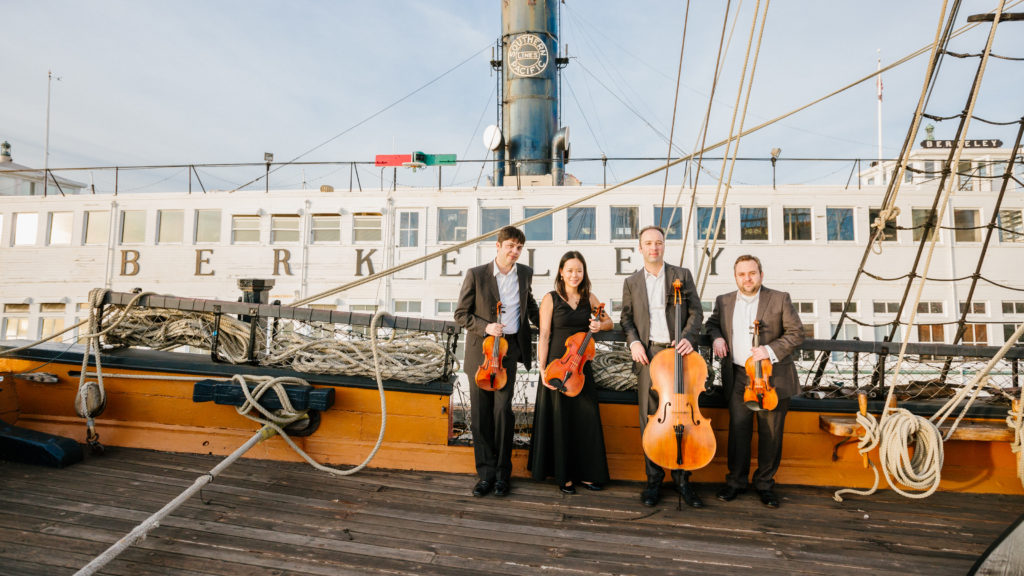The Hausmann Quartet Boldly Champions Schoenberg and Dutilleux on Sunday’s ‘Haydn Voyages’ Program
The programming of Sunday’s installment of the Hausmann Quartet’s Haydn Voyages series encountered some figurative stormy weather. Hausmann opened the concert with Haydn’s cheerful early Quartet in C Minor, Op. 17, No. 4. Its C Minor designation is misleading, however, because apart from the opening and closing phrases of this quartet’s first movement, Haydn stays in blissful major keys throughout. Displaying its well-established advocacy for the composer’s chamber music, Hausmann offered a winning, ingratiating account of this charming, straightforward Classical era string quartet.
After a short introduction by Hausmann’s resident musicologist Derek Katz, the ensemble made a 180 degree stylistic turn and played Henri Dutilleux’s Ainsi la Nuit. Written for the Juilliard Quartet and premiered by that ensemble in 1977, this largely atonal string quartet explores a serious catalogue of traditional and extended string techniques in seven concise, brilliantly constructed movements. Like much of the serious new music from the 1970s, Dutilleux’s idiom appeals more to the intellect than to the heart, but it remains an impressive feat. Numerous string quartets recorded Ainsi la Nuit, including Juilliard and the Arditti Quartet.“Nocturne,” Dutilleux’s opening movement, offers eerie sonic clouds followed by urgent pizzicato clusters and even a serpentine melodic theme from the viola. In the third movement, “Litanies,” the violins produce anxious, whirring themes followed by harsh chordal declamations from the full ensemble. In the second “Litanies” movement, the first violin pursues a hushed, simply plucked theme against static lines from the other players and answered by a subdued lament from the cello. In the final movement, “Temps suspendu,” the upper strings float long, suspended lines over the cello’s insistent pizzicato theme to create a delicate, mysterious finale.
The Hausmann Quartet gave a confident, well-appointed account of this Dutilleux string quartet, and it was well received by the modest audience at the Maritime Museum of San Diego, the ensemble’s regular venue for its Haydn Voyages series. But the Dutilleux tested the patience of a portion of the audience, and they quietly departed during the intermission that followed the Dutilleux.
Following intermission, members of the Hausmann Quartet–violinists Isaac Allen and Bram Goldstein; violist Angela Choong, and cellist Alex Greenbaum–were joined by colleagues violist Travis Maril and cellist Elizabeth Brown to play Arnold Schoenberg’s Verklärte Nacht, Op. 4. Written in 1899, years before Schoenberg started to investigate atonalism or create 12-tone serialism, the sextet Verklärte Nacht is his Valentine to late Romantic style. Musicologist William W. Austin describes Verklärte Nacht as a “Straussian symphonic poem,” although that is probably overstatement.
The addition of another viola and cello to Sunday’s ensemble produced a deep, rich sonority that gave compelling warmth to the sextet, a welcome compensation for the composer’s meandering structure. Kudos to these musicians for making the most of the composer’s dramatic episodes and for expressing a Brahmsian sweetness to many of Schoenberg’s broad themes, even though his harmonic language lacks the comfort of Brahms’ tonal security.
This concert was presented by the Hausmann Quartet on Sunday, May 19, 2024, at the Maritime Museum of San Diego on San Diego Bay.

Ken Herman, a classically trained pianist and organist, has covered music for the San Diego Union, the Los Angeles Times’ San Diego Edition, and for sandiego.com. He has won numerous awards, including first place for Live Performance and Opera Reviews in the 2017, the 2018, and the 2019 Excellence in Journalism Awards competition held by the San Diego Press Club. A Chicago native, he came to San Diego to pursue a graduate degree and stayed.Read more…

